There are ten natural wonders of Asia any dedicated nomad should have on their list of must-sees once in their lifetime. Some of the more surreal places in Asia you can’t see anywhere else in the world and they’re the ones that make packing your backpack and hitting the road totally worth it.
Mount Everest may be the most outstanding, and one of the most famous natural landmarks in Asia, but it’s not the only one. The Ban Gioc waterfall, Jeju Island and Ha Long Bay are all locations that have inspired creative minds to replicate them in their fantasy worlds. In reality, they’re so unique they have to be seen to be appreciated.
All you need to do now is decide which one you’re going to cross off your been there, seen it, done it, list first. Believe it, that won’t be an easy decision.
1. Mount Everest, Nepal/Tibet (China) – the highest mountain in the world

Conquering Mount Everest has to be the ultimate ambition for any serious peakbagger. Even if you only get as far as Base Camp, it’s still something incredible to be able to boast about. Mount Everest is the highest mountain in the world and not many people can say they’ve climbed it. It’s a challenge, there’s no doubt about that, but a doable one if you’re fit enough.
Where Is Mount Everest?
Mount Everest is the most prominent peak in the Himalayan Mountain range. While there’s no visible line marking it, Mount Everest forms part of the boundary between the country of Nepal and the autonomous region of China known as Tibet.
The Nepalese side of the mountain is in the remote, northeastern district of Solukhumbu, east of Kathmandu. The Tibetan side of Mount Everest occupies an area of the even more remote Tingri County which is part of the Qomolangma National Nature Preserve.

Mount Everest Height
Most rocks have a tendency to get smaller over time solely due to the natural process of erosion, not Mount Everest though. Scientists believe that the mountain increases its height by around six millimeters, about a quarter of an inch, every year because of tectonic plate movement. It’s not a growth that’s discernible to the naked eye, but it is a growth that has made the Nepalese and Chinese authorities agree on giving Mount Everest a new official height.
Mount Everest Facts
- Height – 8,848,86 meters (29, 032ft)
- Age – Approximately 50-60 million years
- Annual growth rate – 6mm (1/4″)
- Mount Everest was first climbed in 1953 by Sir Edmund Hilary and Sherpa Tenzing Norgay
- About 4,5000 people have have summited Mount Everest till now
- The record number of climbs in one year was made in 2018 when eight hundred people completed the two month trek to the summit.
- More than 300 people have died attempting to reach the summit of Mount Everest. The most common cause of death isn’t mountain sickness but getting caught in an avalanche
2. Jeju Island, South Korea – Squid Game Player 067’s dream destination
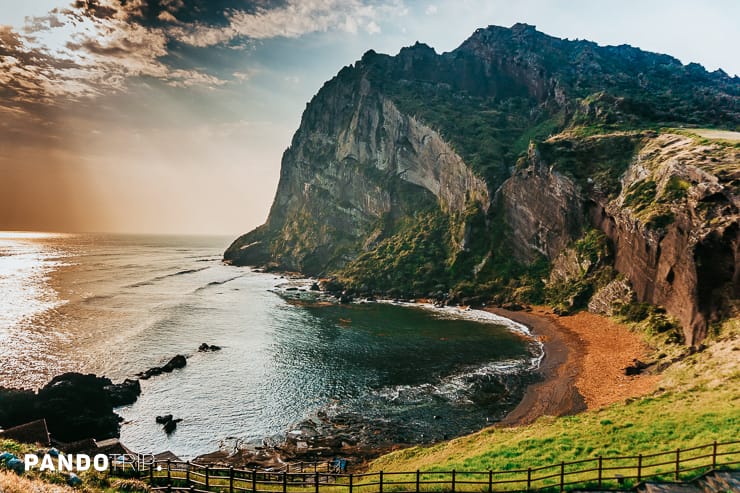
Jeju Island is a large land mass in the Korea Strait and one of the most beautiful natural places in Asia. Jeju is a geologist’s paradise of craters and lava tubes formed by the same volcanic action that created the island.
Hallasan, a bulky mountain topped by a wide volcanic crater containing a lake, dominates Jeju’s central landscapes. The island’s coastline is rimmed with beaches and its interior home to numerous waterfalls. They’re just a few of the many natural assets that draw over twelve million visitors to the island every year.
Alongside Jeju’s amazing natural features are some more unusual ones that have been made by the island’s inhabitants. They might not be the Moai of Easter Island, but the dolharubang, stone grandfathers, of Jeju are still pretty impressive and a lot friendlier looking than the Moai.

Jeju Island and Squid Game
Jeju Island garnered even more attention than it usually gets when it was mentioned in the hit TV series Squid Game by Player 067. Any fan of this horrifically brutal program, which streamed on Netflix for a single season and is reputed to be about to be screened for a second, knows Jeju Island was Player 067s dream destination. She didn’t make it, but there’s no reason why you can’t.
Where Is Jeju Island?
Jeju Island is located in the two-hundred kilometer long Korea Strait which is the channel that separates South Korea from Japan.

Jeju Island Facts
- Jeju Island has had several names during its long history including the Island of Thieves given to it by the Portuguese, but now it is more commonly known as Samdado, the Island of Three Abundances.
- Jeju Island is home to the highest peak in South Korea. Hallasan, or Halla Mountain is an active shield volcano which dominates the Jeju landscape to a staggering height of 1947 meters (6,388ft).
- The island has lots of palm trees and beaches which have rightfully earned it the nickname as the Hawaii of Korea.
3. Komodo Island, Indonesia – A place with dragons and a pink beach

Visiting Komodo Island is about as close as you can get to experiencing a live version of Jurassic Park. The island is home to around four-thousand gigantic Komodo dragons and while they’re not the most attractive of creatures, they’re certainly impressive.
Dragons aren’t the only reason visitors go to Komodo Island. The island’s coast is lined with exceptional coral reefs which are some of the top dive spots on the planet. Komodo is also one of the few places in the world with an incredible pink sand beach.
Where Is Komodo Island?
Komodo Island is in the Lesser Sunda Islands archipelago and part of Indonesia. It’s situated between the larger islands of Flores and Sumbawa. The Savu Sea is to the south and the Flores Sea to the north.
The Komodo Dragons

The monstrous Komodo dragons aren’t dragons at all, but a species of giant monitor lizard that’s native to only a few Indonesian islands. These scaly, forked tongue beasts can live for thirty years or more, grow to a length of three meters when mature and weigh anywhere up to seventy-five kilos. Komodos feed on mammals, dead or alive, including their own young and humans if they can’t run fast enough to get away.
Pink Beach On Komodo Island

Komodo’s famous pink beach, Pantai Merah, lines a bay on the eastern central coast of the island. While the bulk of the sand on the beach is actually white, over time it’s become mixed with fragments of coral that have been turned pink by the excretions of microscopic single cell marine protists called foraminifera. It’s an unusual phenomena and one of only seven examples of its kind in the world.
4. Ban Gioc, China/Vietnam – The most beautiful waterfall in the world
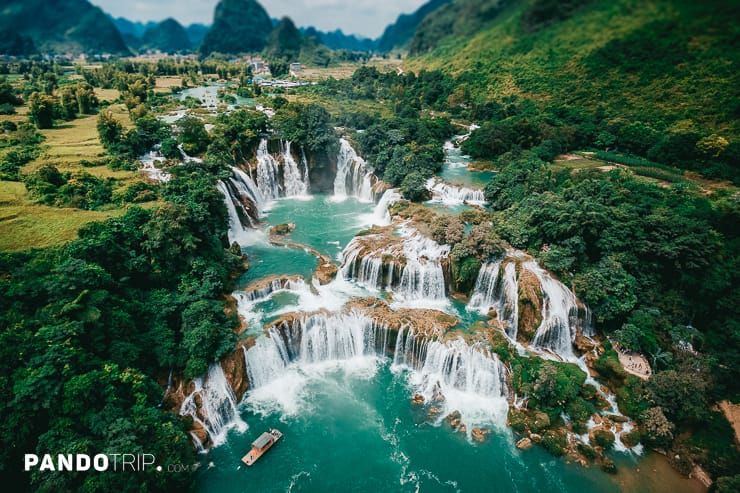
If there are waterfalls in heaven then they’ll probably look like Ban Gioc. There’s a reason Ban Gioc is called the most beautiful waterfall in the world and that reason is simply because it is.
Bian Gioc is located in an area where the river flow has carved its way through the limestone bedrock to create a stunning karst landscape both above and below ground.
Ban Gioc may be a border waterfall, the same as the famous Niagara, Victoria and Iguazu Falls, but this three-tiered, multi-cascade waterfall on the Quay Son River out does all three of them for sheer natural beauty.

Where Is The Ban Gioc Waterfall?
The Ban Gioc Waterfall stretches across the border between Vietnam and China. The Vietnamese section, the waterfall’s east side, is in Daxin County, Guangxi. The Chinese section, the west side, is in the Trung Khanh District of the Cao Bang Province.

Ban Gioc Facts
- Also known as the Ban Gioc – Detian Falls
- Span – 300 meters (985feet)
- Max Drop – 30meters (98feet)
- 4th largest waterfall spanning a national border
- Fed by the Quay Son River and numerous underground springs
5. Ha Long Bay, Vietnam – Emerald green water and thousands of islands

Ha Long Bay in Vietnam has been one of the seven natural wonders of the world for over a decade. It can easily lay claim to being the most surreal place in Asia as it has an other-worldly appearance that’s completely mesmerizing.
The one-thousand nine-hundred plus islands and islets peppering the emerald-colored waters of Ha Long Bay have to be seen to be believed. The islands are, in fact, limestone pillars that have formed as the wind and water has eroded the karst landscape.
Even when you’re there sailing through them, it’s hard to actually comprehend the magnificence of what’s before your eyes. When you go be prepared to be left completely speechless because being lost for words in Ha Long Bay is something unpreventable.

Where Is Ha Long Bay?
Ha Long Bay is in the Gulf of Tonkin off the northeast coast of Vietnam. Only part of the entire area is protected as a UNESCO World Heritage Site. The protected area stretches between the islands of Dau Go, Ba Ham and Cang Tay.

Ha Long Bay Facts
- Ha Long Bay is a vast area of 1,550km² (600 square miles) with approximately 2000 islands and islets.
- Descending dragon is the Vietnamese translation of Ha Long Bay. Descending dragon is a name based on local legend. The myth tells the tale of dragons flying over the bay and spitting out jewels which turned into islands which formed a defense against invading forces.
- In the bay’s six sub-aquatic eco-systems there are almost two hundred different types of coral and four hundred species of fish. According to a 2008 UNESCO study there are also in the region of five hundred types of molluscs in the Cat Ba National Park alone.
6. Dead Sea, Israel/Jordan/Palestine – The lowest point on earth and the world’s saltiest body of water.
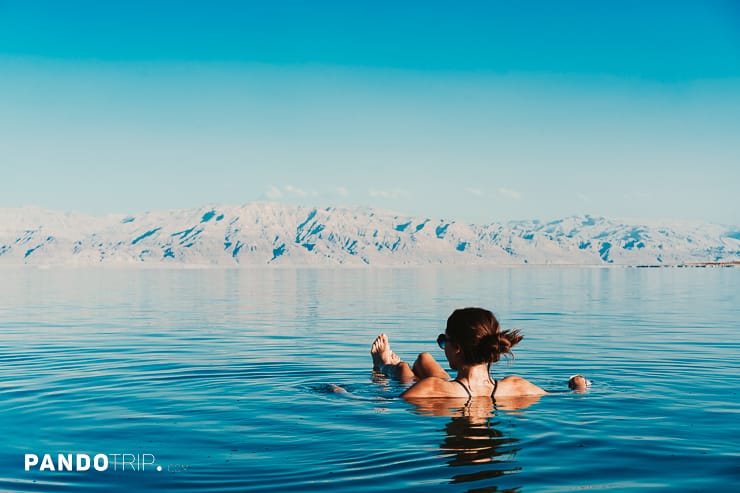
The Dead Sea has been renowned for its healing properties for centuries. People travel to the Dead Sea to float in its salty waters hoping to cure, or at least to improve, all manner of skin conditions. With almost ten times as much salt as any sea or ocean, it’s almost impossible to sink in the Dead Sea’s briny waters, but whether or not they actually work wonders is anyone’s guess.
In all fairness the landscapes surrounding the Dead Sea are not the most scenic. What makes the Dead Sea exceptional, apart from its super salty water, is the fact that the lake’s shorelines are the lowest below sea level land on earth. The sign on the lakeside stating its negative elevation is a popular spot for a social media-worthy selfie.
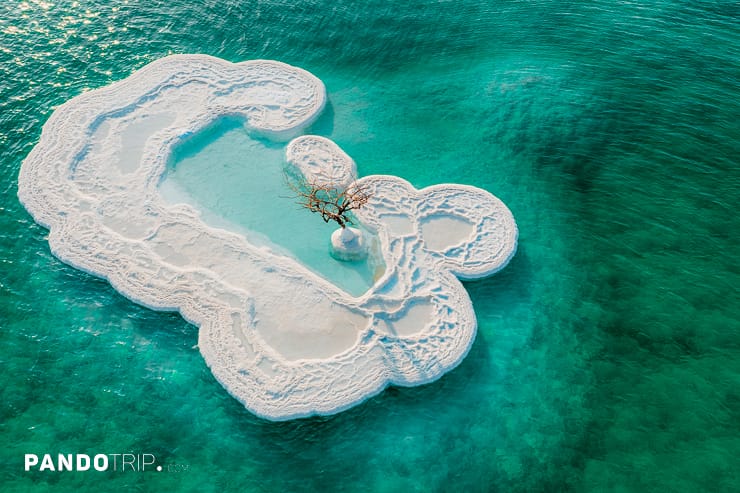
Where Is The Dead Sea?
The Dead Sea is located in the Jordan Rift Valley which is a natural depression stretching between the countries of Jordan and Israel. Jordan borders the lake’s eastern shore and Israel its western one.
Why is the Dead Sea not a sea?
The Dead Sea may be called a sea but it is a hypersaline lake. Over time it’s become known as the Dead Sea because of the salty similarities of its waters to those of a sea or ocean and the fact that nothing other than a few microscopic bacteria can survive there.
The lake is fed by the Jordan River which itself has a high salt level compared to most rivers. The lake’s extra saltiness is caused by rock salt deposits in the lake bed and a high level of evaporation due to the arid climate of the region it’s located in.

Dead Sea Facts
- At -430 meters (-1,412 feet) below sea level, the Dead Sea’s shores are the lowest land point on earth.
- The Dead Sea has a salinity level of 34.2% which is so salty you can float in it with ease.
- There’s no risk of sinking to the bottom of the lake, which is199 meters (653 feet) deep, even if you can’t swim.
7. Gobi Desert, China/Mongolia – The largest desert in Asia?

The Gobi Desert is an immense expanse of sweeping sands, endless enormous dune formations and stark cliffs. It may superficially appear to be devoid of any form of water, but there are rivers above and below the sand as well as several lakes the levels of which are replenished by groundwater.
The Gobi Desert’s sheer vastness means it takes sixth place in the ranks of the world’s largest deserts. While it may look to be uninhabitable, it’s the opposite and is home to a large variety of mammals, aves, reptiles and plantlife.

Is the Gobi Desert the largest desert in Asia?
Whether or not the Gobi Desert is the largest desert in Asia is a question without a simple answer. The Arabian Desert is bigger than the Gobi Desert by a good million square kilometers. That said though, many geologists and cartographers consider the Arabian Desert to be an extension of the Sahara Desert so don’t give it individual status which leaves the Gobi Desert in number one position.
Where Is The Gobi Desert?
The Gobi Desert is sandwiched between the countries of China and Mongolia forming a sandy border between the two. China is to the south of the desert and Mongolia to the north. At its furthest western reach, the Gobi joins with the Taklamakan Desert of northwest China.
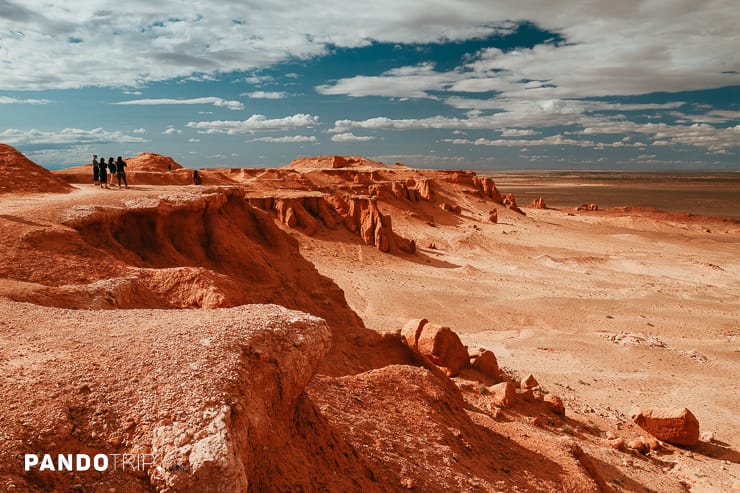
Gobi Desert Facts
- Area – 1,295,000 km² (500,002 square miles)
- Maximum Width – 800 km (500 miles)
- Grains of Sand – incalculable
- While the Gobi Desert may appear uninhabitable it’s actually anything but. The desert sustains a huge variety of flora and fauna. Common mammals seen in the desert are gazelles, wild Bactrian camels, polecats and Gobi bears. Other species that are also spotted using the desert as a habit are wolves and snow leopards.
- The Gobi Desert can experience incredible changes in temperature within a short space of time. Those extreme changes can be as much as 35ºC in a twenty -four hour period . The highest temperatures are recorded in the summer months and the lowest in winter when the dunes are often capped with snow.
8. Mount Fuji, Japan – A symbol of Japan and one of the most famous mountains in the world

Along with Mount Everest, Mount Fuji is one of the most instantly recognisable landmarks in the world. It may not be the highest mountain in Japan, but it does like to make its presence known.
Mount Fuji is an attractive, but still active stratovolcano classed as one of the top ten most stunning volcanoes in the world. If you’re a volcano tourist contemplating hiking to the summit the fact it continues to be active isn’t too much to worry about as it hasn’t erupted since 1708.
Mount Fuji is, without a doubt, one of Japan’s outstanding natural wonders and an icon of the country which is worshiped by the Japanese as sacred. The area around its base, Fuji Five Lakes, while recently being granted UNESCO World Heritage status, is also an amazing recreational zone with hot springs, hiking trails and an amusement park.

Where Is Mount Fuji?
Mount Fuji is located in the Fuji-Hakone-Izu National Park which is in a central eastern area of the Japanese island of Honshu. It is approximately one hundred kilometers from the country’s capital, Tokyo.
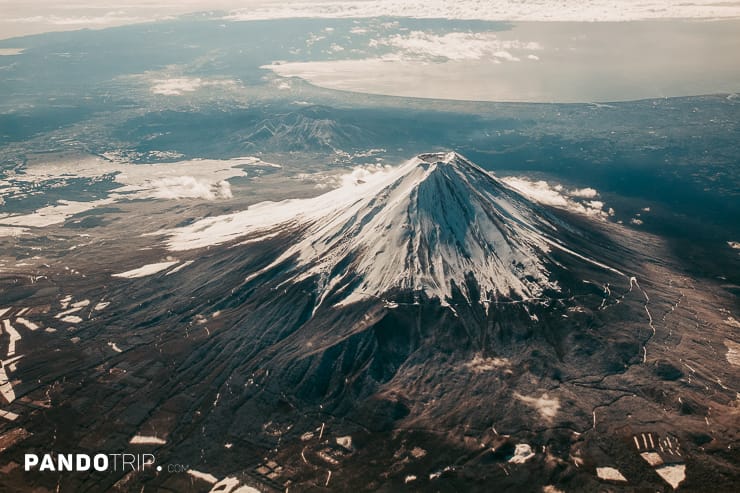
Mount Fuji Facts
- Volcano Type – Stratovolcano
- Height – 3776 meters (12,388 feet)
- Last Eruption – 1708
- Mount Fuji became a UNESCO World Heritage Site in June of 2013.
- To get the best views of this magnificent mountain, known as Fujisan in Japanese, you need to be at Fuji Five Lakes.
- Fuji Five Lakes is also the best point to set off from to hike to the summit of this stratovolcano which hasn’t erupted since 1708.
9. Puerto Princesa Underground River, Philippines – One of the world’s longest underground waterways
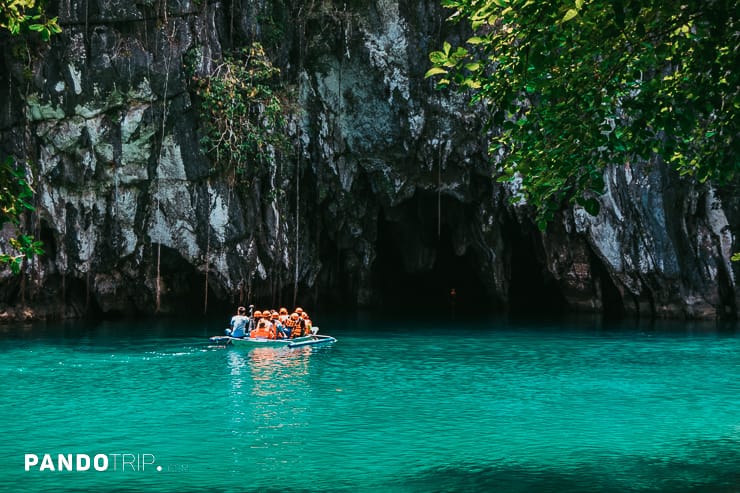
Any really intrepid traveler will have the Puerto Princesa Underground River on their bucket list. While a recent discovery on the Yucatan Peninsula in Mexico means this subterranean river in Palawan is no longer the world’s longest, it’s still one of those surreal places in Asia that will leave you open-mouthed with wonder.
If you’ve read mixed reviews about the Puerto Princesa Underground River on the internet, forget them because this is one of the top ten things to see and do in the Philippines and no mistake. As you sail into the entrance listening to the chatter of monkeys, you’ll feel as if you’re heading to the center of the earth.
It’s like entering into the land that time forgot only without the dinosaurs and thankfully, it’s a lot easier to get back out. The subterranean waterway flows through the enormous St Paul’s Underground River Cave where there are extravagant displays of stalagmites and stalactites as well as plenty of bat colonies.

Where Is The Puerto Princesa Underground River?
The Puerto Princesa Underground River is located in the Puerto Princesa Subterranean River National Park. The park occupies a large piece of territory on the west coast of Palawan Island in the Philippines that is a UNESCO World Heritage Site.

Puerto Princesa Underground River Facts
- Underground River Length – 8.2 km (5 miles)
- Rock type – Karst
- River – Cabayugan River
- Cave Length – 24 km (15 miles)
10. Maldives – The world’s greatest island destination

If there’s anywhere that should be at the top of an article rather than at the bottom it’s the Maldives. This archipelago of islands, not surprisingly, ranks high on the list of top islands for a holiday and there’s several good reasons for that.
The Maldives have some of the cleanest and clearest waters anywhere in the world. Dive into them and you won’t be thinking about pollution but experiencing sublime aquatic bliss. The resorts in the Maldives are next level too so if you’re looking for one of those wooden, thatched roof huts surrounded by crystalline sea and not a lot else you’re in the right place.

Where Are The Maldives?
The twenty six islands the Maldives consist of are located in the Indian Ocean around seven-hundred and fifty miles of the coast of Sri Lanka and India.
Maldive Facts
- Number of Islands – 26
- Total Area Covered – 90,000 km² (35,000 square miles)
- Largest Island – Gan
- The Maldives covers a total area of 90,000 km² (35,000 square miles) which makes it the eighth smallest country in the world.
- It’s also the smallest Asian country and the smallest country where the majority of the population follow the Muslim religion.
- With no areas of ground higher than 2.4 meters (8feet) above sea level, the Maldives can also justly lay claim to being the flattest country in the world.

